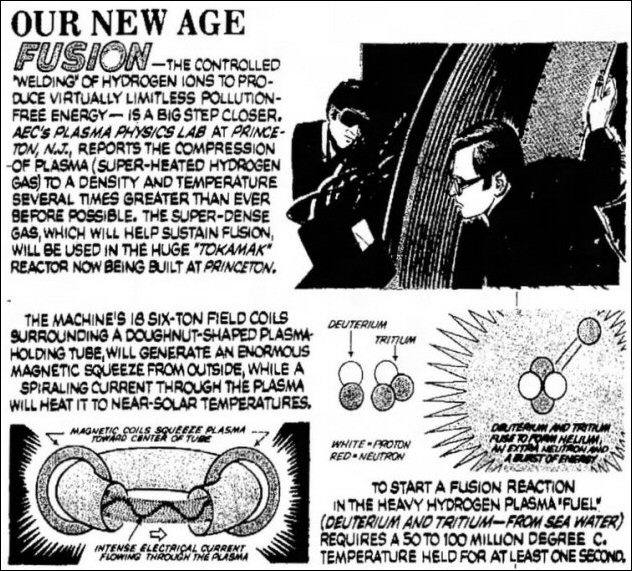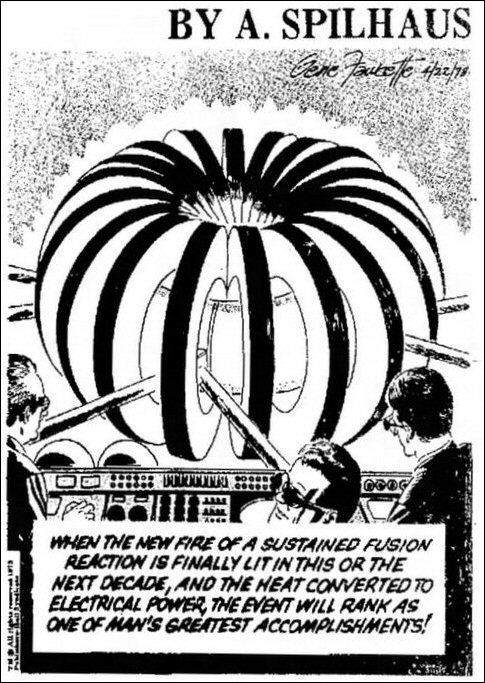40. Avec ITER, Plus ça Change, Plus C’est La Même Chose
Return to ITER Power Facts Main Page
By Steven B. Krivit
Aug. 3, 2020
Fusion scientists have been making the same qualitative promises for more than 44 years. With ITER, they only added the quantitative promise of fusion particles with 500 MWth.
JET – 1976
“This proposal describes a large tokamak experiment, which aims to study plasma behaviour in conditions and dimensions approaching those required in a fusion reactor. … The experiment known as the Joint European Torus (JET) involves building and studying a large tokamak type device and should yield decisive results on the practical feasibility and definition of a Tokamak reactor. … Possible performance data for JET: Ignition Domain … The essential objective of JET is to obtain and study a plasma in conditions and dimensions approaching those needed in a thermonuclear reactor.”
— European Commission Proposal for JET (PDF)
TFTR – 1978
“The [Tokamak Fusion Test Reactor] will not be an ordinary fusion research device. For some 30 years, physicists have been trying to achieve breakeven fusion energy — to get out more energy than they put in. The TFTR seems likely to reach that goal in the early 1980s. When that happens, scientists will have proved that fusion power is scientifically feasible. The next step will be to construct a fusion reactor that generates electricity.”
— Popular Science, (Journalist Edward Edelson) (PDF)
CIT – 1986
“A preliminary design has been completed for a nuclear reactor that scientists hope will be the first to create a fusion reaction that will achieve ignition, thus sustaining itself at temperatures of hundreds of millions of degrees. … The new American project, the Compact Ignition Tokamak, would be the last step before construction of the Engineering Test Reactor, an international effort meant to test the practicality of producing useful power in this manner.”
— New York Times (Journalist Walter Sullivan) (URL)
ITER – 2002
“the possibility of controlled ignition should not be precluded.
Engineering Performance and Testing
The device should:
• demonstrate the availability and integration of technologies essential for a fusion reactor (such as superconducting magnets and remote maintenance);
• test components for a future reactor (such as systems to exhaust power and particles from the plasma);
• Test tritium breeding module concepts that would lead in a future reactor to tritium self-sufficiency, the extraction of high grade heat, and electricity – production.
– International Atomic Energy Agency ITER Design Objectives and Mission (PDF)
ITER – 2012
According to the present roadmap, a demonstration fusion power plant (DEMO), producing net electricity for the grid at the level of a few hundred Megawatts is foreseen to start operation in the early 2040s. Following ITER, it will be the single step to a commercial fusion power plant.
-EFDA Roadmap (PDF)
ITER – 2020
“ITER is the last essential experiment before we produce fusion energy on a commercial basis. It is an experiment, it will not produce energy for the grid. ITER has to prove that we have the fundamental understanding of how to contain the burning plasma, how to keep it burning, self sustained.”
— ITER Organization Public Relations Office (Sabina Griffith) July 29, 2020 (Audio clip)

Our New Age Cartoon (1975)

Our New Age Cartoon (1975)

